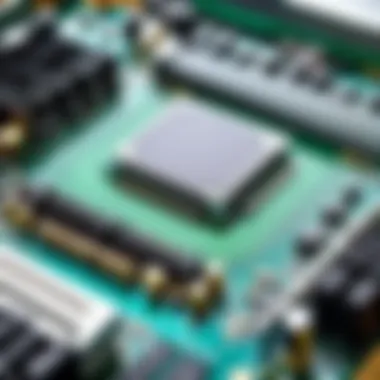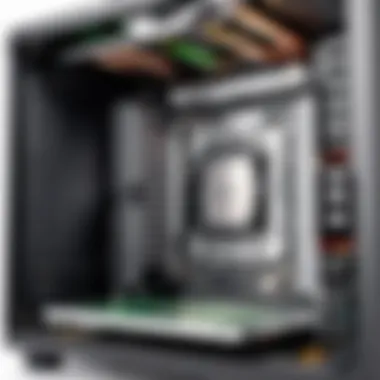Building a High-Performance Gaming PC: Complete Guide


Intro
Building a personal computer capable of running contemporary games effectively is not a task to be taken lightly. For IT professionals and tech enthusiasts, understanding the essential components is crucial. This guide will provide a comprehensive exploration of the hardware specifications and performance metrics needed for an optimal gaming experience. From the significance of compatibility to practical assembly guidelines, each section will equip readers with the knowledge necessary for informed decision-making in their gaming setups.
Hardware Overview
When it comes to building a gaming PC, hardware is the foundation. The components chosen can significantly impact overall experience. Focusing on specifications and performance metrics will help in creating a system that meets individual gaming needs.
Specifications
Key components to consider include the central processing unit (CPU), graphics processing unit (GPU), random access memory (RAM), and storage solutions. Each of these parts plays a vital role:
- CPU: The most significant factor in overall system performance. A high-performance CPU will handle complex calculations and multitasking efficiently.
- GPU: Essential for high-quality graphics rendering. For gaming, a powerful GPU is non-negotiable, as it directly influences frame rates and visual fidelity.
- RAM: Adequate RAM allows for smooth gameplay, enabling quick data accessibility. A minimum of 16GB is recommended for modern gaming.
- Storage: Solid State Drives (SSDs) provide faster load times compared to traditional Hard Disk Drives (HDDs). It is advisable to use SSDs for the operating system and frequently played titles.
Performance Metrics
Understanding performance metrics is key to discerning which hardware will provide the desired experience. Important metrics to monitor include:
- Frame Rates (FPS): Indicates how many frames are rendered every second. Higher FPS translates to smoother gameplay.
- Latency: The delay between input and display. Low latency is preferable for competitive gaming.
- Resolution: The clarity of the image that the monitor displays. Higher resolution requires more powerful hardware to maintain fluid performance.
"Performance in gaming is a delicate balance between hardware choice and optimization."
Being aware of these metrics allows builders to adjust their components and expectations per their gaming preferences.
Software Analysis
After the hardware is chosen, consideration must be given to the software. The operating system and drivers play an integral role in performance.
Features and Functionality
Modern operating systems like Windows 10/11 offer several features pertinent to gaming, such as:
- Game Mode: Prioritizes gaming resources, assisting in performance during heavy use.
- DirectX: Provides essential APIs for gaming graphics and is a standard for many games.
Installing the proper drivers for the GPU is also critical. Outdated drivers can result in reduced performance and compatibility issues.
User Interface and Experience
The interface that comes with an operating system affects user experience. A clean, organized desktop and accessible apps enhance enjoyment while gaming. Tools like Steam and Nvidia GeForce Experience streamline game management and updates, allowing users to focus on playing rather than setup.
Ultimately, knowing how software interacts with hardware is fundamental to maximizing performance.
This guide will delve deeper into each section, synthesizing information from expert sources and practical experience. Prepare to explore the exciting world of gaming PC assembly!
Understanding Gaming PCs
Understanding what constitutes a gaming PC is fundamental for anyone looking to build a personal computer specifically for gaming. In this section, we will delve into the critical elements and benefits associated with gaming PCs, as well as the considerations that must be taken into account during the building process. A gaming PC requires robust hardware and precise compatibility between components to deliver a superior performance in modern gaming environments.
Defining a Gaming PC
A gaming PC is defined as a personal computer that is built or optimized to handle the demands of modern video games. Unlike typical desktop computers, which may suffice for basic tasks, a gaming PC incorporates high-performance components intended for graphics-intensive applications. These include fast CPUs, powerful GPUs, ample RAM, and efficient cooling systems. The distinction between a standard PC and a gaming PC lies in the hardware specifications that each encompasses. In essence, gaming PC configurations not only support high-resolution displays but also ensure smooth gameplay across various titles, adapting to the needs of both casual gamers and competitive players.
The Evolution of Gaming Hardware
Over the years, gaming hardware has evolved dramatically, paralleling advancements in technology and gaming design. Early gaming systems were rudimentary, often requiring basic graphics and processing capabilities. As games became more intricate, the hardware needed to support such complexity naturally followed.
Today, gaming PCs utilize cutting-edge components that provide significant advantages. The introduction of multi-core CPUs and high-performance GPUs has transformed gaming experiences. Furthermore, the development of solid-state drives has dramatically reduced loading times. Other innovations, such as liquid cooling options and modular power supplies, have enhanced system efficiency and ease of upgrades.
The investment in superior hardware has become essential, as game developers continually push the limits of what is possible in visual and cognitive gaming experiences. As a result, understanding the evolution of gaming hardware is essential for making informed decisions about building your own system.
Key Components of a Gaming PC


Building a gaming PC involves selecting the right components that ensure optimal performance and compatibility. Each element plays a crucial role in the overall gaming experience. Understanding these components helps enthusiasts make informed decisions that align with their gaming needs and preferences.
Central Processing Unit (CPU)
Importance in Gaming
The CPU is often referred to as the brain of the computer. It handles all the calculations and instructions that allow games to function. A powerful CPU improves frame rates and manages tasks more efficiently during intensive gaming scenarios. A multi-core processor, such as the AMD Ryzen 7 or Intel Core i7, is popular. These CPUs offer excellent performance in modern games, particularly those that rely heavily on processing power.
Choosing the Right CPU
When selecting a CPU, consider its clock speed and the number of cores. A higher clock speed translates to better performance in single-threaded games. Conversely, more cores are beneficial for multi-threaded applications, including simulation games and open-world titles. Aim for at least four cores to ensure a smooth gaming experience. Consider the future gaming requirements, as newer titles may demand more power.
Graphics Processing Unit (GPU)
Understanding GPU Performance
The GPU is crucial for rendering graphics in games. It significantly affects the visuals and frame rates. High-performance GPUs such as NVIDIA GeForce RTX 3080 or AMD Radeon RX 6800 XT provide excellent graphics capabilities. These GPUs can handle high resolutions and settings, making them essential for gamers seeking immersive experiences.
Selecting a Suitable GPU
When choosing a GPU, evaluate factors like VRAM and performance benchmarks. VRAM should be sufficient for the always-increasing graphical demands of current games. A GPU with at least 8GB of VRAM is recommended for future-proofing. Additionally, check reviews and comparisons to see how different models perform across various games. This helps in making a well-informed decision.
Memory (RAM)
Role of RAM in Gaming
RAM allows your system to process and manage tasks quickly. In gaming, sufficient RAM contributes to smoother gameplay and faster loading times. A minimum of 16GB is generally suggested for modern gaming setups. This ensures that background applications do not interfere with gaming performance.
Optimal RAM Specifications
When selecting RAM, also consider its speed and compatibility with the motherboard. RAM speed can enhance performance in some games, especially those sensitive to memory bandwidth. Opting for dual-channel RAM configurations can provide a boost in performance compared to single-channel setups. The specifications for speed (measured in MHz) and timings can impact gaming efficiency.
Storage Solutions
SSD vs. HDD
Storage types directly affect loading times and overall system responsiveness. SSDs (Solid State Drives) offer faster performance compared to traditional HDDs (Hard Disk Drives). Using an SSD for your operating system and the most-played games is recommended, while an HDD can serve as secondary storage for less frequently accessed files. This combination optimizes performance without sacrificing storage capacity.
Storage Capacity Considerations
When considering storage capacity, account for game sizes, which can often exceed 100GB. A 1TB SSD may suffice for several games, with additional storage through an HDD for other files. Evaluate your gaming habits to determine the right capacity, ensuring you have adequate space as game files continue to grow in size.
Motherboard Compatibility
Choosing the Right Motherboard
Selecting a motherboard that fits your CPU is critical. Motherboards vary in features, including support for different CPU sockets and RAM types. It is also wise to consider the number of expansion slots and ports to support future upgrades. A quality motherboard balances price with performance and compatibility, ensuring a solid foundation for your build.
Understanding Chipsets
Chipsets determine how the motherboard communicates with other components. Different chipsets offer varying levels of performance features like overclocking capabilities and connectivity options. For high-performance gaming, consider chipsets from Intel's Z-series or AMD's B-series and X-series, which can provide additional functionalities tailored for gaming and overclocking.
Power Supply Unit (PSU)
Power Needs for Gaming PCs
The PSU is essential because it provides stable power to all components. Ensuring your PSU has the capacity to support your system is vital. When building a gaming PC, calculating the total wattage required is specific to the combined power requirements of the CPU, GPU, and other components. A PSU with at least 80 Plus certification guarantees efficient power usage.
Selecting Quality PSUs
Choosing a reliable PSU from reputable brands can prevent system failures and damage during operation. Factors like modularity can enhance your build's cable management, while the warranty period can signal build quality. Focus on branded PSUs like Corsair or Seasonic, and aim for a wattage rating slightly above your requirements to accommodate future upgrades.
Gaming Resolution and Performance


Understanding gaming resolution and performance is crucial for building a gaming PC that meets your desired experience. These factors directly influence how visually impressive games appear and adjust how fluidly they run. Players often demand higher resolutions and frame rates for an immersive experience. Consequently, it is essential to know the capabilities of your hardware and how they align with your gaming expectations.
Understanding Resolutions
Resolution relates to the number of pixels displayed on the screen. Higher resolutions bring out finer details and richer graphics, essential for an engaging gaming experience. The three most recognized resolutions are 1080p, 1440p, and 4K. Each resolution offers a unique benefit:
1080p, 1440p, and 4K
- 1080p (Full HD): This resolution is 1920x1080 pixels. It is the most common choice for gamers, especially those who prioritize performance and affordability. It ensures clarity without overwhelming graphics cards. It is good for competitive gaming.
- 1440p (QHD): With a resolution of 2560x1440 pixels, 1440p strikes a balance between visual fidelity and performance. It provides more detail than 1080p and is becoming increasingly popular among gamers who want quality.
- 4K (Ultra HD): This resolution has 3840x2160 pixels, offering the best visual quality. It is ideal for those who want a cinematic experience. However, it requires powerful hardware and is usually more expensive.
The key characteristic of these resolutions is their pixel count, which directly affects how sharp the image appears on screen. For those wanting top performance alongside stunning visuals, 1440p typically serves as a sweet spot between 1080p and 4K.
Frame Rates and Gaming Experience
Frame rates, measured in frames per second (FPS), are essential to how smooth the gameplay experience is. Higher frame rates lead to more responsive and fluid gameplay. Different games may require different frame rates to operate correctly.
Minimum Frame Rate Recommendations
Minimum frame rate recommendations help gamers understand how low a frame rate can go without detrimental effects. Many gamers aim for at least 60 FPS to ensure a smooth and enjoyable experience. Playing below this can cause lag and disruptions.
However, competitive gamers may strive for even higher rates, often exceeding 144 FPS to gain an upper hand in fast-paced scenarios. Here, performance becomes crucial in gameplay, as slight differences can impact outcomes.
Achieving Smooth Gameplay
Achieving smooth gameplay extends beyond maintaining a particular frame rate. It involves optimizing settings and ensuring your hardware meets necessary specifications. Utilizing technologies such as FreeSync or G-Sync can minimize screen tearing and enhance fluidity.
The unique feature of smooth gameplay is its capacity to provide an uninterrupted experience. This quality reflects directly on enjoyment; higher frame rates can create a more engaging atmosphere. For those seeking to take their gaming further, investing in quality components for stability is always wise.
For gamers, maintaining a balance between resolution and frame rate can significantly enhance the overall experience.
Building Your Gaming PC
Building a gaming PC is a practical endeavor that enables one to tailor their gaming experience to personal preferences and performance requirements. This section outlines the crucial elements involved in the process, provides essential benefits of undertaking this task, and offers considerations to keep in mind when assembling your machine. A custom-built gaming PC can lead to enhanced performance, better cost-efficiency, and greater control over components compared to pre-built alternatives. Furthermore, the ability to upgrade individual parts ensures longevity in terms of gaming capabilities.
Preparing for Assembly
Gathering Tools and Components
Gathering the right tools and components is the foundation for a successful build. Essential tools like a screwdriver, anti-static wrist strap, and cable ties contribute to a smooth assembly process. Ensuring that you have all required parts like CPU, GPU, RAM, and motherboard on hand helps prevent interruptions during assembly. Additionally, sourcing these components with care can lead to discovering superior choices that elevate performance. Many people find that selecting components that are well-reviewed leads to a more secure and reliable gaming experience.
One significant characteristic of gathering tools and components is compatibility. Always check that the chosen motherboard supports the CPU and RAM type you intend to use. This attention to compatibility is prudent, as investing in unsuitable parts can lead to wasted time and resources.
Understanding Safety Precautions
Understanding safety precautions is vital when building any PC. This involves managing static electricity and handling components carefully. Wearing an anti-static wrist strap while working reduces the risk of damaging sensitive hardware. It is critical to be aware of how to properly ground yourself, as even a small static discharge can damage components. This proactive measure is a sensible choice that can save trouble down the line.
Taking precautions also includes maintaining a tidy work area. Clutter can lead to accidental damage or misplacement of components. A clean space supports unwavering focus and promotes efficiency in the assembly process.
Assembly Steps
Installing the CPU
Installing the CPU is an essential step that significantly impacts overall performance. The CPU acts as the brain of your PC, processing tasks and instructions, hence opting for a powered processor is crucial. The installation process involves aligning the CPU correctly with the socket and locking it in place. This careful step ensures optimal performance capabilities.
An important aspect of installing the CPU is thermal paste application. A thin layer of thermal paste helps in heat transfer between the CPU and cooler, preventing overheating. Neglecting this can lead to performance issues or hardware failure.
Installing the GPU
Installing the GPU is another critical phase of the assembly, particularly for game performance. The GPU handles all graphical processing, making it a key component for gaming experiences. Position the GPU in the designated PCIe slot and ensure it is securely fastened. This careful placement maximizes graphical performance.
One should also consider power consumption when selecting a GPU. Higher-end GPUs often demand more power, meaning that the power supply unit might require upgrades. Being aware of such requirements is vital for optimal system performance.


Connecting Power Supply
Connecting the power supply is a final step that brings life to the system. The power supply unit (PSU) must be appropriately linked to the motherboard and other components. It’s important to ensure that all cables are securely connected to avoid any power issues that may arise during usage. A strong and reliable PSU is a beneficial choice, allowing consistent power delivery across the entire system.
Another aspect to consider is the wattage. Selecting a power supply that exceeds the total wattage required helps accommodate potential future upgrades.
Post-Build Configuration
BIOS Settings
BIOS settings play a pivotal role in ensuring that the components function optimally. After completing the assembly, accessing the BIOS allows users to configure boot options and system settings. This setup includes enabling XMP for RAM, which can enhance memory performance.
Adjusting BIOS settings can lead to improved system stability and performance, an essential consideration for any gaming PC.
Operating System Installation
Operating system installation is the last step to a functional gaming rig. Choosing an OS that aligns with gaming needs transforms the PC into a versatile tool for play. Windows is a common choice due to its extensive library of games and compatibility.
During installation, partitioning the drive properly is crucial. Doing this optimizes storage management, ensuring efficient use of available space. Sufficient preparation at this phase can significantly enhance the overall user experience.
Maintaining Your Gaming PC
Maintaining your gaming PC is critical for ensuring optimal performance and longevity of your components. Regular upkeep prevents issues that might compromise the gaming experience. Moreover, the appropriate maintenance can save money in the long term, avoiding costly repairs and replacements. This section delves into the two fundamental aspects of maintenance: regular cleaning and monitoring of performance. Each plays a crucial role in keeping your system running smoothly, which is paramount for gamers who rely on high performance for their experience.
Regular Cleaning and Upkeep
A clean PC is essential for its efficient operation. Dust accumulation inside the case can obstruct airflow, leading to overheating components. To ensure that your gaming PC functions at its best, schedule regular cleaning.
Steps for Regular Cleaning:
- Shut Down and Unplug: Always turn off your computer and unplug it before cleaning. This is crucial for safety.
- Open the Case: Most cases have screws or thumb screws that allow easy access.
- Use Compressed Air: Gently blow out dust from fans, heat sinks, and other components. Avoid using a vacuum, as it can create static electricity.
- Wipe Surfaces: Use a lint-free cloth to clean surfaces. This includes removing smudges on the windows or metallic parts.
- Check Connections: Inspect cables and connections while inside the case to ensure they are firm.
Cleaning should be done every few months, depending on your environment. If you live in a dusty area or have pets, more frequent cleaning may be necessary. This habit will also promote airflow, leading to quieter fans and longer component life.
Monitoring Performance
Performance monitoring is an ongoing task that helps you understand how your gaming PC is handling loads. Several tools can help track CPU usage, GPU loads, and temperatures. Keeping definite tabs on these factors allows you to pinpoint issues before they escalate.
Key Components to Monitor:
- Temperature: High temperatures might indicate inadequate cooling. Most CPUs and GPUs have temperature thresholds that shouldn’t be exceeded.
- Usage Levels: Knowing how much of your CPU or GPU is being utilized can help identify bottlenecks. If a component is maxed out while others are underutilized, it might be time for an upgrade.
- Frame Rates: Regularly check the frame rates during gaming. If frame rates drop significantly, it might indicate hardware strain or driver issues.
Using software tools such as HWMonitor or MSI Afterburner can assist in this task. These applications provide a comprehensive view of system metrics in real-time. Regular performance monitoring can assist in enhancing gaming performance while addressing potential issues before they affect gameplay.
By maintaining your gaming PC, you not only extend its life but also ensure you can enjoy the latest games smoothly without unexpected interruptions.
Future Trends in Gaming Technology
Understanding the future trends in gaming technology is essential for anyone involved in building or enhancing a gaming PC. Staying informed about these trends allows users to make well-informed purchasing decisions, ensuring their systems remain relevant and capable of handling new developments. Significant advancements in gaming technology are reshaping the landscape, providing opportunities for better performance, enhanced experiences, and innovative gameplay.
Moreover, the rise of cloud-based solutions and the integration of artificial intelligence play pivotal roles in gaming. These elements not only influence hardware requirements but also alter game development itself. As gamers and builders, recognizing these shifts is critical for optimizing systems for upcoming challenges and possibilities.
The Rise of Cloud Gaming
Cloud gaming has emerged as a transformative force in the industry. It allows players to stream games directly from remote servers instead of relying solely on local hardware capabilities. This shift can lead to several advantages:
- Accessibility: Players can enjoy games on a range of devices without the need for high-end hardware. A stable internet connection becomes the main requirement instead of an expensive gaming rig.
- Cost Efficiency: By reducing the reliance on powerful components, users save on upfront costs associated with building a high-performance gaming PC.
- Instant Play: With cloud gaming, there’s no need to download or install games, allowing immediate access to a robust library of titles.
However, there are considerations that gamers must keep in mind. A high-speed and reliable internet connection is crucial for a seamless experience. Additionally, latency issues can affect gameplay, particularly in fast-paced games where timing is crucial. Balancing these factors will determine how effective and enjoyable cloud gaming will be for various audiences.
Impact of Artificial Intelligence
Artificial intelligence is also reshaping the gaming landscape. Its applications range from enhancing player experiences to optimizing game development processes.
- Smarter NPCs: AI-driven characters can adapt to player behaviors, providing a more immersive and challenging experience. They can learn from previous interactions, making each playthrough unique.
- Procedural Generation: Games are increasingly using AI to create dynamic environments and quests. This technology can result in vast and varied game worlds, reducing redundancy and keeping players engaged for longer.
- Game Optimization: AI can analyze player performance and adjust game difficulty in real-time. This personalized approach helps to maintain a suitable challenge, catering to different skill levels.
However, this reliance on AI poses potential risks, such as the ethical implications of machine learning and data collection practices in gaming. Developers must be meticulous to ensure that these innovations enhance rather than detract from the user experience.
"The integration of AI into gaming not only changes gameplay but also redefines how we interact with digital worlds."



